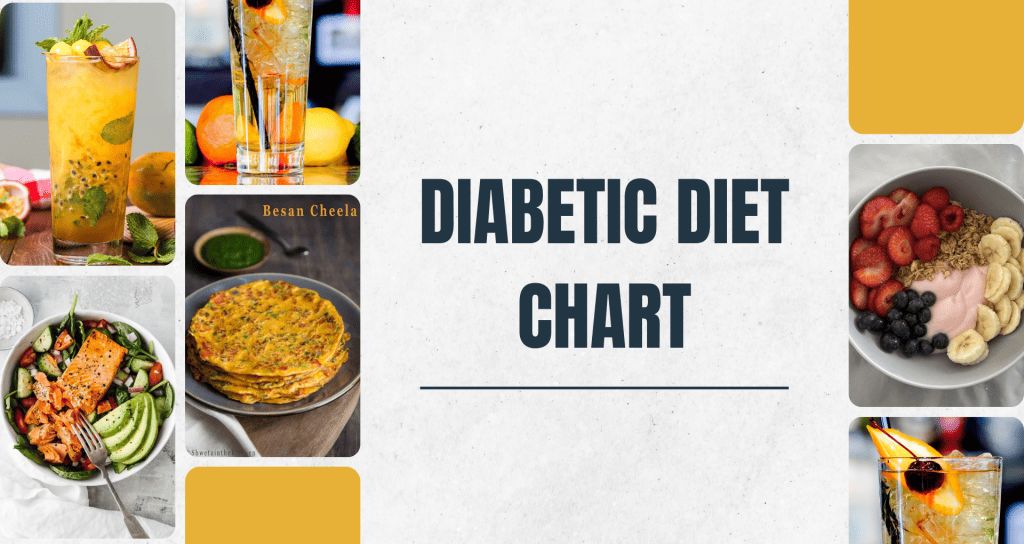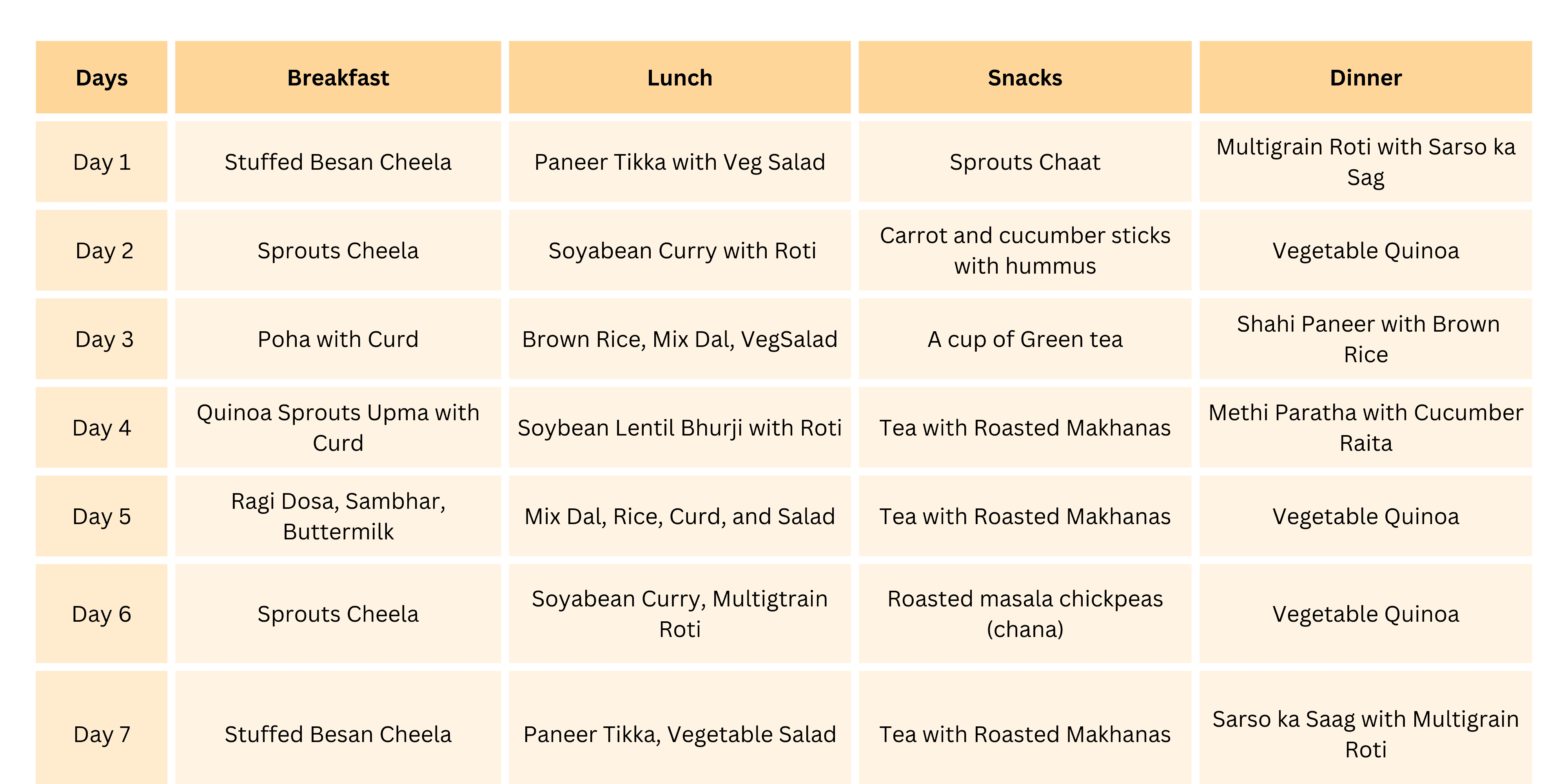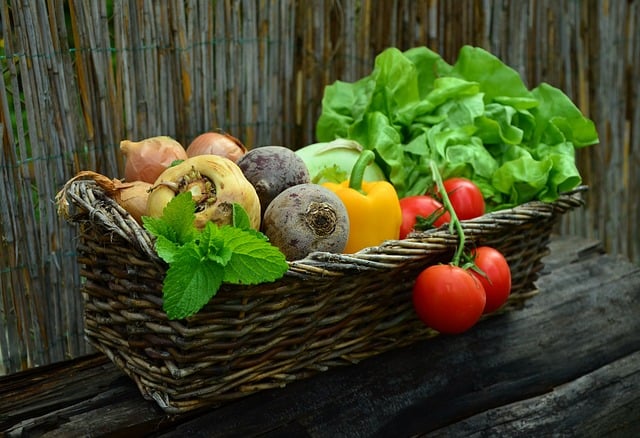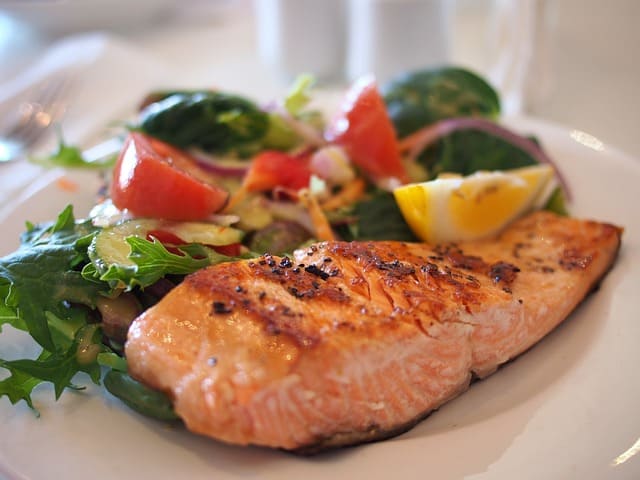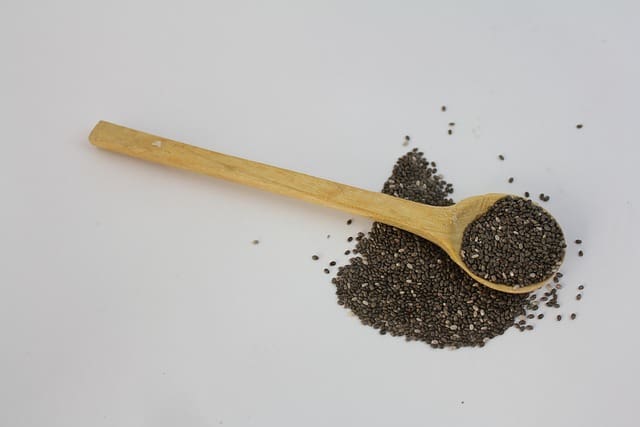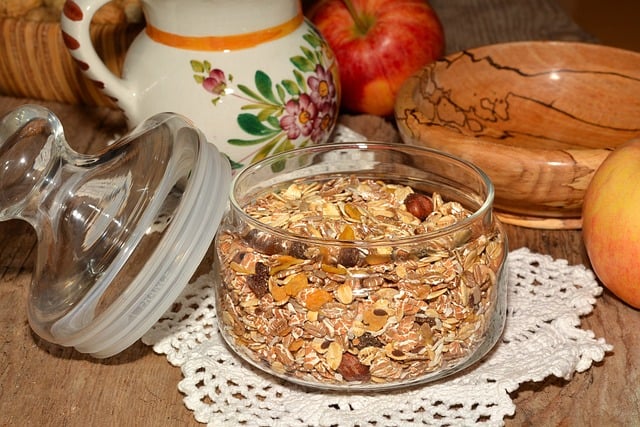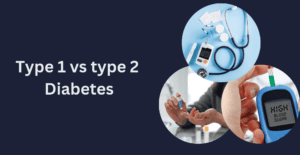Diabetes is a condition that requires careful attention to the type of food you consume, the timing of your meals, and how much you eat to keep your blood glucose level, also called your blood sugar level, in a healthy range. Research says you can still enjoy the foods you like by making them healthier and being mindful of portion size. Not only nutrition and eating habits but physical activities also significantly impact regulating the blood sugar level.This blog will focus on the relationship between food and diabetes management. It’s also important to know that studies also suggest that no one meal plan will work for everybody; you can experiment and understand with the help of your doctor to create a personalized diabetic diet chart.
What is a Diabetic Diet Chart?
A diet chart for Diabetes is a meal plan that helps you actively change your eating habits to regulate your blood sugar level in a targeted range. It will have all the essential foods required according to your body type and, yes, your favourite foods curated more healthily!
A good diabetes diet chart will have the following:
- Balanced carbohydrate intake: because the sugar in your blood comes from certain foods called carbohydrates, or ‘carbs’.
- Fibre-rich foods are good for heart health by stabilizing blood sugar levels.
- Your favourite meals in controlled portion sizes.
- A variety of vegetables and lean proteins give you adequate nutrition.
Importance of following a Diabetic Diet Chart
When you have a health condition, there are some foods that are good for you and foods which can make your condition worse. Therefore, it becomes essential to be more aware of the food you are consuming, which can positively or negatively impact your body in the long run. This dietary approach helps regulate carbohydrate intake, preventing rapid spikes in blood sugar. It supports weight management, which is vital for diabetes control. By controlling blood sugar levels, a diabetic diet chart reduces the risk of diabetic complications such as nerve damage, heart disease, kidney problems, and vision issues.
Moreover, following a structured diabetic diet chart educates individuals about food choices, portion sizes, and the impact of different foods on blood sugar levels. It empowers better food decisions, fostering long-term habits for improved health, enhanced quality of life, and better diabetes management.
Following a diabetic food chart can give you a clear idea of what to eat and avoid, which can help you manage your blood sugar levels.Well you can check on how to reduce blood sugar immediately with the help of this blog.
7 Day Indian Diet Chart for Diabetic Patients
Food is crucial if you want to manage your blood sugar levels. Certain foods do not raise your blood sugar levels as others do. You can make a great meal by adding these foods to a diabetic diet chart.
Diet Chart For Diabetic Patients – Day 1
Given below is the diabetic diet chart for day 1
| Diet Chart For Diabetic Patients – Day 1 | |||||
| Breakfast | Stuffed Besan Cheela | ||||
| Lunch | Paneer Tikka with Vegetable Salad | ||||
| Snacks | Sprouts Chaat | ||||
| Dinner | Multigrain Roti with Sarso ka Saag | ||||
Breakfast: Stuffed Besan Cheela
Besan has a low GI which means it does not spike your blood sugar levels. It also has a good amount of fibre and protein which can aid digestion and make you feel fuller for longer. It is a great meal to be added to a Indian diabetic diet chart.
Lunch: Paneer Tikka with Vegetable Salad
Panner is home to good amounts of protein. It contains all the essential amino acids the body requires to help build and repair muscles. It also has a low glycemic index making it a great addition to the Indian diabetic diet chart. You can buy diabetes plans and consult a nutritionist to make a customized diet plan for you according to your requirements.
Snacks: Sprouts Chaat
It’s loaded with protein, fibre, and essential vitamins, making it an excellent choice for diabetics. This chaat is seasoned with Indian spices and fresh vegetables, offering a tasty and blood sugar-friendly option for snacks.
Dinner: Multigrain Roti with Sarso ka Saag
Unlike refined grains, rotis made from multigrain do not spike your blood sugar levels and provide the body with a constant and slow release of energy. Saag (spinach) has fibre in it which helps to control blood sugar levels. Always make sure to include complex carbs in your diabetic diet chart. You can learn more about diabetic-friendly foods at diabetes blogs
Diet Chart For Diabetic Patients – Day 2
Given below is the diabetic diet chart for day 2
| Diet Chart For Diabetic Patients – Day 2 | |||||
| Breakfast | Sprouts Cheela | ||||
| Lunch | Soyabean Curry with Multigrain Roti | ||||
| Snacks | Carrot and cucumber sticks with hummus | ||||
| Dinner | Vegetable Quinoa | ||||
Breakfast: Sprouts Cheela
Sprouts, being low in calories and high in protein and fibre, are an excellent choice for people with Diabetes. This is a great breakfast option that is light, keeps you fuller for longer, and is a great meal to add to your diabetic diet chart.
Lunch: Soyabean Curry with Multigrain Roti
Soybean is made out of defatted soy flour, which is low fat. It is an excellent source of protein as well. Multigrain rotis should be a part of every Indian diabetic diet chart as it does not spike your blood sugar levels. Just like foods, the right diabetes products can also help better manage Diabetes.
Snacks: Carrot and cucumber sticks with hummus
Carrot and cucumber sticks with hummus are a low-glycemic, fibre-rich snack that helps stabilize blood sugar and provides a mix of vitamins, minerals, and healthy fats.
Dinner: Vegetable Quinoa
Quinoa has good amounts of dietary fibre and is a great food option for people with Diabetes, as fibre-rich food it helps to control blood sugar levels. Quinoa is often suggested to people with Diabetes as an alternative to rice in their diabetic diet chart.Learn more on how to control sugar levels.
Diet Chart For Diabetic Patients – Day 3
Given below is the diabetic diet chart for day 3
| Diet Chart For Diabetic Patients – Day 3 | |||||
| Breakfast | Poha with Curd | ||||
| Lunch | Brown Rice with Mix Dal and Vegetable Salad | ||||
| Snacks | A cup of green tea | ||||
| Dinner | Shahi Paneer with Brown Rice | ||||
Breakfast: Poha with Curd
Poha is light and has fibre, which is beneficial for controlling blood sugar levels. Curd, on the other hand, has reasonable amounts of calcium, which is required to maintain healthy bones. It is one of the best meals to be added to a sugar patient diet chart.
Lunch: Brown Rice with Mix Dal and Vegetable Salad
Brown rice is an excellent option for people with Diabetes. The combination of rice and dal can reduce the glycemic index of the entire meal. Also, the vegetable salad will provide you with fibre and make you feel fuller for longer.
Snack: A cup of Green tea
A cup of green tea provides antioxidants and may help improve insulin sensitivity, making it a potentially beneficial beverage for individuals with Diabetes. It can also aid in weight management and overall well-being.
Dinner: Shahi Paneer with Brown Rice
Paneer has a low glycemic index. People with Diabetes can add it to their diabetic diet chart. Ensure the shahi paneer recipes are made with less oil and low-fat ingredients.
Diet Chart For Diabetic Patients – Day 4
Given below is the diabetic diet chart for day 4
| Diet Chart For Diabetic Patients – Day 4 | |||||
| Breakfast | Quinoa Sprouts Upma with Curd | ||||
| Lunch | Soybean Lentil Bhurji with Roti | ||||
| Snacks | Tea with Roasted Makhanas | ||||
| Dinner | Methi Paratha with Cucumber Raita | ||||
Breakfast: Quinoa Sprouts Upma with Curd
Quinoa has good amounts of fibre in it, which helps to control blood sugar levels in the body. If you are looking to add a good source of calcium to your diabetic food chart then curd is a great option.
Lunch: Soybean Lentil Bhurji with Roti
Soybean and lentils are a great source of protein, and roti made with mixed grains are a good source of slow-releasing carbs. Foods like these have minimal to no effect on the blood sugar level, so it should be a part of a sugar patient diet chart.
Snack: Tea with Roasted Makhanas
Makahnas is one of the best foods to increase insulin sensitivity. It can be added to your diabetic food chart.
Dinner: Methi Paratha with Cucumber Raita
Methi is really beneficial for people with Diabetes as it helps to lower blood sugar levels. Cucumber is one of the best foods to regulate blood sugar levels in the body.
Diet Chart For Diabetic Patients – Day 5
Given below is the diabetic diet chart for day 5
| Diet Chart For Diabetic Patients – Day 5 | |||||
| Breakfast | Ragi Dosa and Sambhar with Buttermilk | ||||
| Lunch | Mix Dal and Rice with Curd and Salad | ||||
| Snacks | Tea with Roasted Makhanas | ||||
| Dinner | Vegetable Quinoa | ||||
Breakfast: Ragi Dosa and Sambhar with Buttermilk
Ragi should be a part of the sugar patient diet chart as it is high in fibre and an excellent alternative to white rice. It helps digestion and makes you feel fuller for longer, which reduces food cravings.
Lunch: Mix Dal and Rice with Curd and Salad
This is a complete meal that provides you with carbs and protein. Having salad daily helps with digestion and can also help to control blood sugar levels. Add this meal to your diabetic diet chart to stabilize blood sugar levels.
Snacks: Tea with Roasted Makhanas
Having makhana as a part of your diabetic food chart can help the body fight against oxidative stress and improve insulin sensitivity. Makahanas are light, have very few calories, and can be added to diet charts for sugar patients.
Dinner: Vegetable Quinoa
Quinoa is often recommended to people with Diabetes as it has a good amount of fibre. It helps regulate blood sugar levels and is a great food to add to a sugar patient’s diet chart.
Diet Chart For Diabetic Patients – Day 6
Given below is the diabetic diet chart for day 6
| Diet Chart For Diabetic Patients – Day 6 | |||||
| Breakfast | Sprouts Cheela | ||||
| Lunch | Soyabean Curry with Multigtrain Roti | ||||
| Snacks | Roasted masala chickpeas (chana) | ||||
| Dinner | Vegetable Quinoa | ||||
Breakfast: Sprouts Cheela
Cheela is made out of dal, and sprouts have a good amount of fibre. Together, they make a great meal that provides the body with many nutrients and helps control blood sugar levels. This is one of the best meals to add to the diet chart for sugar patients.
Lunch: Soyabean Curry with Multigtrain Roti
Soybean has protein, and multigrain roti provides the body with slow-releasing carbs. It is one of the best meals to be added to a diabetic food chart.
Snacks: Roasted masala chickpeas (chana)
Roasted masala chickpeas, or masala chana, are a popular Indian snack made by roasting chickpeas with a flavorful blend of spices. They provide a burst of taste and energy without causing rapid spikes in blood sugar levels.
Dinner: Vegetable Quinoa
Quinoa contains fibre and protein, which helps to lower blood sugar levels in the body. It is light and can easily be added to your diabetic food chart.
Diet Chart For Diabetic Patients – Day 7
Given below is the diabetic diet chart for day 7
| Diet Chart For Diabetic Patients – Day 7 | |||||
| Breakfast | Stuffed Besan Cheela | ||||
| Lunch | Paneer Tikka with Vegetable Salad | ||||
| Snacks | Tea with Roasted Makhanas | ||||
| Dinner | Sarso ka Saag with Multigrain Roti | ||||
Breakfast: Stuffed Besan Cheela
Besan cheela is high in fibre and protein content, which helps to lower the blood sugar levels in the body. It is a great breakfast option for people with diabetes and can be added to the Indian diabetic diet char Apart from this, oats are also a great option to be added to a diabetic diet chart.
Lunch: Paneer Tikka with Vegetable Salad
Paneer has a low glycemic index, meaning it does not spike blood sugar levels. Vegetable salad has many essential vitamins and minerals. Vegetable salad is widely suggested to be added to an Indian diabetic diet chart.
Snacks: Tea with Roasted Makhanas
Makahanas are a great snack option for people with Diabetes. It is low in calories and helps the body fight against oxidative stress. This can be added to the sugar patient diet chart easily.
Dinner: Sarso Ka Saag with Multigrain Roti
Multigrain roti is a better option to add to your diabetic food chart than regular roti. It does not digest quickly, so it won’t raise your blood sugar levels and provide the body with a steady release of energy. Many doctors add high-fibre vegetables to an Indian diabetic diet chart. High fibre vegetable such as broccoli is also a great addition to diabetic diet chart.
Quick Glance at 7 Days Diet Chart For Diabetic Patients
Let’s take a quick glance at the 7-day diet chart for Diabetes.
Benefits of following Diet Chart for Sugar Patients
A well-designed diet chart can offer several benefits for individuals with high blood sugar levels or diabetes:
- Blood Sugar Control: A diet plan tailored for individuals with diabetes helps manage blood sugar levels. It often includes foods that have a limited impact on blood sugar, such as complex carbohydrates, high-fiber foods, and lean proteins.
- Weight Management: A diabetic diet can aid in weight control or loss, which is crucial for many individuals with diabetes. Maintaining a healthy weight can improve insulin sensitivity and blood sugar control.
- Heart Health: A balanced diet can contribute to heart health, which is vital as individuals with diabetes are at a higher risk of heart disease. It typically involves reducing saturated fats, cholesterol, and sodium while increasing the intake of heart-healthy fats like omega-3 fatty acids found in fish.
- Stable Energy Levels: A well-structured diet plan can help regulate energy levels throughout the day, preventing spikes and crashes in blood sugar, which can affect energy levels and mood.
- Preventing Complications: Proper nutrition can help prevent or delay complications associated with diabetes, such as kidney disease, nerve damage, and vision problems.
- Improved Insulin Sensitivity: Eating the right foods in proportions can enhance insulin sensitivity, allowing the body to use insulin more effectively.
- Better Nutrient Intake: A diabetes-specific diet emphasizes various nutrient-dense foods, ensuring individuals get essential vitamins, minerals, and antioxidants necessary for overall health.
- Customization: Diet plans can be tailored to individual needs, considering age, weight, activity level, and personal preferences. This customization makes it easier to follow and sustain the diet long-term.
- Education and Awareness: Following a diet chart for diabetes often involves learning about portion control, carbohydrate counting, and understanding how different foods affect blood sugar levels. This education empowers individuals to make informed food choices.
- Lifestyle Integration: Incorporating a balanced diet into daily life encourages healthy habits, such as regular exercise, stress management, and adequate sleep, which are essential for managing diabetes effectively.
Foods to eat while following Diabetic Patients Diet Chart
If you have Diabetes, then you have to be careful with what foods you choose to eat and for that you need to follow an Indian diabetic diet chart. Certain foods will help you to manage this condition better. You can add these foods to your diabetic diet chart.
1. Leafy Green Vegetables
Consuming green leafy vegetables daily can benefit the body in many ways. Leafy green vegetables are low in calories, so having a bowl of vegetable salad won’t affect your fitness goals but only make you healthier. It includes plenty of vegetables, fruits for diabetic patients in moderation, whole grains, nuts, seeds, and lean proteins like fish or poultry, fostering stable blood sugar levels and overall health.These vegetables have certain starch-digesting enzymes which help to lower and control the blood sugar levels in the body. Apart from this, leafy green vegetables have a high fiber content which means they aid in digestion and make you feel fuller for longer, reducing your cravings and appetite. This can stop you from eating anything unhealthy which might interfere with your blood sugar levels. Doctors often recommend leafy green vegetables to be added to an Indian diabetic diet chart.
2. Cinnamon
Many people think of various foods when it comes to controlling blood sugar levels. Did you know multiple spices can help in lowering your blood sugar levels? One of them is cinnamon. It is widely used in Indian household cooking and offers a lot of health benefits. Cinnamon is excellent at increasing the body’s insulin sensitivity, which lowers blood sugar spikes. It also helps by acting like insulin and easing the movement of sugar into the cells. If you have Diabetes, then adding some cinnamon to your diabetic diet chart can help you manage the condition. Spices like Turmeric are also added to an Indian diabetic diet chart.
3. Fatty Fish
Consuming seafood, especially fatty fish, can help with Diabetes and lower the chances of further complications from Diabetes. Fatty fish contain omega-3 fatty acids, which help to boost heart and brain health. Many scientists have proposed that consuming fatty fish can reduce the chances of developing Type 2 Diabetes. Fishes like salmon are beneficial and can be a great addition to your diabetic diet chart. You can add any fish high in omega-3 fatty acids to your diabetic diet chart.
4. Chia Seeds
Chia seeds are home to various vitamins and minerals such as Vitamin B1, B3, iron, and calcium. Apart from this, it is also great for people with Diabetes. It has good fibre content, which can help reduce blood sugar levels. It’s definitely worth adding to your diabetic diet chart. A bowl of morning oatmeal with chia seeds sprinkled on top can be a great breakfast option that can be added to a diet chart for sugar patients.
5. Apple Cider Vinegar
A study published in the diabetes care journal has shown that consuming apple cider vinegar can increase insulin sensitivity and help lower blood sugar levels. Also, a new trial has concluded that drinking apple cider vinegar before bedtime can reduce waking glucose concentrations. You can add apple cider vinegar to your diabetic diet chart to gain its benefits.
6. High Fiber Foods
A lot of people need to pay more attention to eating high-fiber foods. These can be really beneficial for the body and can help lower and regulate blood sugar levels in the body. Foods such as oats, quinoa, and leafy greens should be added to a sugar patient diet chart as they have good amounts of fibre in them. These foods provide the body with a slow release of energy and do not spike your blood sugar levels. Adding high-fibre foods to your diet chart of Diabetes can help you to manage your blood sugar levels better.
Foods To Avoid In Sugar Patients Diet Chart?
In Diabetes, it is really important to consume foods that do not raise your blood sugar levels. Here are a few foods you should avoid at all costs, and these should never be a part of a sugar patient diet chart.
1. Foods Containing Saturated Fat
Saturated fat is also known as bad fat as it is responsible for raising the cholesterol levels in the body, which can eventually lead to heart issues. Foods high in saturated fat are really high in calories and can easily throw you off track if you are on a weight loss journey or trying to live a healthy lifestyle. Foods such as cream, processed foods, and fatty meat are high in saturated fats. These foods should be miles away from your diet chart of Diabetes.
2. Foods Containing Transfat
Transfats are the end result of liquid oils being turned into solid fats. Trans fat can be found in many processed foods such as cakes, pies, and pastries. Consuming foods high in trans fat can increase the chances of many cardiovascular diseases as transfat is responsible for raising bad cholesterol in the body. Avoid including foods with transfat in your diabetic diet chart.
3. Foods Containing Sodium
People who have Diabetes are at a higher risk of developing heart disease. Therefore, it is important to avoid foods that contain too much salt, as foods that are high in sodium can increase blood pressure and cause heart disease. It can also cause water retention in the body. If you have a sugar patient in your family, then advise them to stay away from excess sodium and not add it to a sugar patient diet chart. You can also make low-salt recipes at home and add them to your diet chart for Diabetes.
4. Foods Containing Cholesterol
In Diabetes, the inner lining of the arteries gets damaged, and this increases the chances of cholesterol sticking to them. People with Diabetes generally have low levels of good cholesterol and higher levels of bad cholesterol. Therefore, it is really important to avoid consuming foods high in cholesterol.
5. Foods Containing Excess Sugar
For Diabetics, refined sugar is the enemy. There is nothing good about refined sugars. All it does is make the body more prone to various chronic illnesses. It also causes weight gain in the body if consumed in excess amounts. A sugar patient diet chart should not have any refined sugars in it.
Some Recipes for Sugar Patients Diet Chart
If you are suffering from Diabetes, then learning how to make some healthy recipes can be really beneficial for you. Not only these are delicious but also offer a lot of health benefits. You can add these diabetes recipes to your diabetic diet chart to get maximum benefits.
1. Instant Pot Chickpea Curry with Spinach
This recipe offers a lot of nutrients and is really easy to make. Chickpeas do not raise your blood sugar levels as they have a low glycemic index. Spinach has magnesium in it, which reduces the chances of developing Type 2 diabetes. You can add this recipe to your diabetic diet chart.
2. Yogurt Oats
This recipe is not only healthy but will also satisfy your taste buds. Oats are great for people with Diabetes as they are slow-digesting carbs, which means they do not raise your blood sugar levels. Yoghurt is a great source of calcium. It is easy to make and should definitely be added to a sugar patient diet chart.
3. Dahi Bhindi Recipe
This recipe has many health benefits and also a great taste. It’s easy to make and is great for people with Diabetes. It has good amounts of fibre in it, which makes it a perfect recipe for a sugar patient diet chart.
Expert Review on Diabetic Diet Chart
Diabetes can be really hard to manage. The right nutrition, however, can help you to manage Diabetes in a better way. Different foods will impact your blood sugar levels differently. It’s always important to pick foods that won’t spike your blood sugar levels. Having a Diabetic diet chart can help you to keep track of what foods to eat and at what time, which can help you to manage your blood sugar levels in a better way. With the right determination, you can defeat Diabetes. Check out these diabetes success stories.
References
“Diabetes Diet, Eating, & Physical Activity – NIDDK.” n.d. National Institute of Diabetes and Digestive and Kidney Diseases. Accessed October 15, 2023. https://www.niddk.nih.gov/health-information/diabetes/overview/diet-eating-physical-activity.
“Diabetes Meal Planning – Diabetes Meal Planning.” n.d. CDC. Accessed October 15, 2023. https://www.cdc.gov/diabetes/managing/eat-well/meal-plan-method.html.
“Diabetic Diet.” 2021. MedlinePlus. https://medlineplus.gov/diabeticdiet.html.
FAQ’s
What is the best diet for a diabetic patient?
A well-rounded diet for a diabetic patient emphasizes whole foods, lean proteins, healthy fats, and complex carbohydrates with a low glycemic index. A balanced diet rich in vegetables, fruits, whole grains, lean proteins, and healthy fats, emphasizing portion control and managing carbohydrate intake, is ideal for diabetic patients.
What is the best meal for diabetics?
A balanced meal for people with diabetes comprises lean protein, healthy fats, fibre-rich carbohydrates, and vegetables. An example is grilled salmon with quinoa, steamed broccoli, and a side salad with leafy greens and olive oil dressing. This meal offers a mix of nutrients, minimal impact on blood sugar, and supports overall health.
Which food is good for diabetics?
Foods beneficial for people with diabetes include leafy greens like spinach and kale, berries rich in antioxidants, nuts and seeds for healthy fats, whole grains such as quinoa and oats, and lean proteins like chicken or fish. These options stabilize blood sugar, offer essential nutrients, and support overall well-being for people with diabetes
What are 3 rules of a diabetic diet?
Three key rules for a diabetic diet include:
- Portion Control: Managing portion sizes of carbohydrates, proteins, and fats helps regulate blood sugar levels and prevents overeating.
- Choosing Complex Carbs: Opting for whole grains and high-fibre foods over refined sugars maintains more stable blood glucose levels.
- Monitoring Sugar Intake: Being mindful of added sugars in foods and beverages is crucial to prevent blood sugar spikes.
What foods can diabetics eat daily?
People with diabetes can include daily leafy greens and non-starchy vegetables for fibre and nutrients, berries with antioxidants and low sugar content, nuts and seeds for healthy fats, whole grains like oats or quinoa for fibre, and lean proteins such as chicken or tofu for essential amino acids without impacting blood sugar significantly.
Do I have to follow a diet chart of diabetes daily?
Following a diabetes-specific diet chart daily is beneficial for managing blood sugar levels and overall health. Consistency in meal planning helps stabilize glucose levels, manage weight, and reduce the risk of complications. However, it’s essential to adapt the plan based on individual needs and consult healthcare professionals for personalized guidance.
What is a sugar patient diet chart?
A sugar patient diet chart typically outlines portion-controlled meals focused on low-glycemic foods. It includes whole grains like quinoa, vegetables, lean proteins such as fish or poultry, healthy fats like avocados, and limited added sugars. This plan aims to stabilize blood sugar levels and promote overall well-being for individuals managing diabetes.

